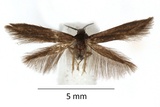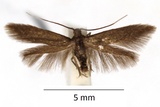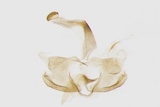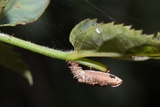Coleophora violacea (Ström, 1783) Species
Last modified: Dec. 20, 2024, 3:46 p.m.
A not so common species in Belgium but found throughout the country after 2004.
Details
- Classification
- Family: Coleophoridae > Genus: Coleophora > Species: Coleophora violacea
- Vernacular names
- Witsprietkokermot (NL), Violet case-bearer (EN)
- Synonyms
- Coleophora paripennella sensu auct., nec Zeller, 1839
- First mention in Belgium
- De Fré Ch. 1858. Catalogue des Microlépidoptères de la Belgique. — Annales de la Société entomologique belge 2: 45–162. On page 141 (as C.[oleophora] Paripennella. F. v. R.). view page
- Status
-
Native
Distribution
Case
The brown case is lobe-shaped and is lying almost flat on its leaf, so the mouth angle is 0°. Ventrally, there is a distinct keel.
See also bladmineerders.be.
Mine
The fleck mines are rather large, round and brownish.
Bionomics
The eggs are deposited on the underside of a leaf of the food plant. The caterpillars feed on both sides of the leaves and are fully grown in October.
Cases are easily found in springtime on e.g. smooth Alnus stems.
The adults fly in early evening and later come to light.
Flight periods
The adults fly in one generation a year, from late May to early July.
Observed on
- Host plant (genera):
- Malus, Prunus, Rosa, Rubus, Betula, Ulmus, Alnus and Tilia
- Substrates:
- Herbaceous plants and Deciduous trees
This species is extremely polyphagous, over 30 species of food plants are known and the larva lives on Rosaceae and on woody plants including Alnus, Castanea, Potentilla, Rubus, Symphoricarpus, Tilia, Viburnum, etc...




